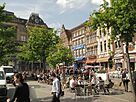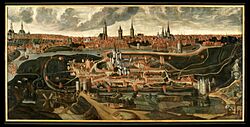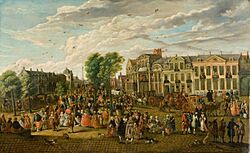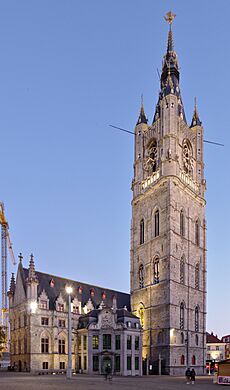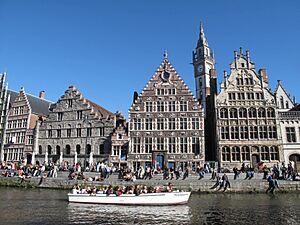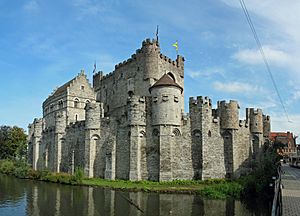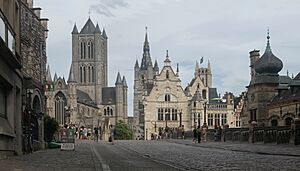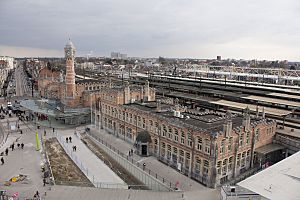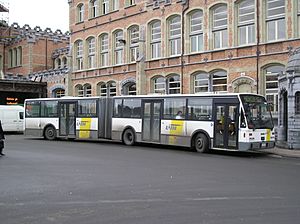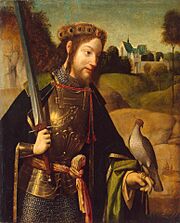Ghent facts for kids
Quick facts for kids
Ghent
Gent (Dutch)
Gand (French)
|
|||
|---|---|---|---|
|
Clockwise from top: the Graslei, the Gravensteen, Ghent Tower Row (St. Nicholas' Church, Belfry, St. Bavo's Cathedral), and the Vrijdagmarkt
|
|||
|
|||
| Country | Belgium | ||
| Community | Flemish Community | ||
| Region | Flemish Region | ||
| Province | East Flanders | ||
| Arrondissement | Ghent | ||
| Area | |||
| • Total | 156.18 km2 (60.30 sq mi) | ||
| Population
(2018-01-01)Lua error in Module:Wd at line 1575: attempt to index field 'wikibase' (a nil value).
|
|||
| • Total | Lua error in Module:Wd at line 1,575: attempt to index field 'wikibase' (a nil value). | ||
| Postal codes |
9000–9052
|
||
| Area codes | 09 | ||
| Website | www.gent.be | ||
|
|
|||
Ghent (pronounced "Gent" in Dutch, "Gand" in French) is a large city in the Flemish Region of Belgium. It is the capital of the East Flanders province. Ghent is the third-largest city in Belgium, after Brussels and Antwerp. It is an important port city and home to a big university.
The city began where the Scheldt and Leie rivers meet. In the Late Middle Ages, around the year 1300, Ghent was one of the biggest and richest cities in northern Europe, with about 50,000 people. After the 16th century, Ghent became less important. This actually helped keep its historic center very well-preserved. Today, Ghent is a popular place for tourists to visit.
The city of Ghent includes the main city and many smaller towns around it. These include Afsnee, Desteldonk, Drongen, Gentbrugge, Ledeberg, Mariakerke, Mendonk, Oostakker, Sint-Amandsberg, Sint-Denijs-Westrem, Sint-Kruis-Winkel, Wondelgem and Zwijnaarde. At the start of 2019, Ghent had 262,219 people, making it Belgium's second-largest city by population. The wider area around Ghent has over 560,000 people. The current mayor of Ghent is Mathias De Clercq.
Every year, Ghent hosts a ten-day festival called the Gentse Feesten. About 1 to 1.5 million people visit this festival.
Contents
History of Ghent
Humans have lived around the Scheldt and Leie rivers since the Stone Age and Iron Age.
Most historians think the old name for Ghent, 'Ganda', comes from a Celtic word meaning 'where rivers meet'. This refers to the Leie river flowing into the Scheldt. Some people also link the name to an old god named Gontia.
There are no written records from the Roman times, but old digs show people continued to live in the Ghent area. When the Franks moved into Roman lands from the late 300s to the 400s, they brought their language. This led to Old Dutch replacing Celtic and Latin.
Ghent in the Middle Ages
Around the year 650, Saint Amand started two important abbeys in Ghent: St. Peter's and St. Bavo's Abbey. Later, around 800, Louis the Pious, son of Charlemagne, put Einhard in charge of both abbeys. The city grew from these abbeys and a trading center. However, in 851 and 879, Vikings attacked and robbed the city.
Ghent recovered and grew strong from the 11th century, protected by the County of Flanders. By the 1200s, Ghent was the biggest city in Europe north of Paris. It was even larger than Cologne or Moscow. Up to 65,000 people lived inside its city walls. The belfry and the towers of St. Bavo's Cathedral and St. Nicholas' Church are examples of the tall buildings from that time.
The rivers in Ghent often flooded the land, creating rich grassy areas called 'meersen'. These were perfect for raising sheep. The wool from these sheep was used to make cloth. Ghent became the most important city for cloth making during the Middle Ages. The wool industry in Ghent was so advanced that wool had to be brought in from Scotland and England. This led to good trade relationships. However, during the Hundred Years' War, trade with England became very difficult. John of Gaunt, an English duke, was born in Ghent.
Early Modern Times in Ghent
The city got stronger again in the 1400s when Flanders joined with nearby areas under the Dukes of Burgundy. But high taxes led to a rebellion and a big defeat for Ghent in 1453. Around this time, the most important cities in the Low Countries (like Belgium and the Netherlands today) started to shift from Flanders to Brabant. Still, Ghent remained important.
In 1500, Charles V was born in Ghent. He later became a powerful emperor and king of Spain. Even though he was from Ghent, he punished the city after a rebellion in 1539. He made the city's nobles walk barefoot with a rope (called a "strop" in Dutch) around their necks. Because of this, people from Ghent are still called "Stroppendragers" (noose bearers). St. Bavo's Abbey was torn down and replaced with a fort for Spanish soldiers.
The late 1500s and 1600s were tough due to the Eighty Years' War. This war ended Ghent's role as a major international city. In 1745, French forces took over the city during the War of the Austrian Succession. It was given back to Austria in 1748. This part of Flanders was known as the Austrian Netherlands until Napoleon I was defeated in 1815.
Ghent in the 19th Century
In the 1700s and 1800s, Ghent's textile industry became strong again. Lieven Bauwens secretly brought plans for industrial machines from England. In 1800, he set up the first mechanical weaving machine on the European continent.
The Treaty of Ghent was signed here on Christmas Eve 1814. This treaty officially ended the War of 1812 between Great Britain and the United States. After the Battle of Waterloo, Ghent became part of the United Kingdom of the Netherlands for 15 years. During this time, Ghent opened its own university (1816) and a new canal to the sea (1824–27).
After the Belgian Revolution, Ghent lost its easy access to the sea for over ten years, and its economy suffered. The first Belgian trade union started in Ghent. In 1913, Ghent hosted a world exhibition. The Sint-Pieters railway station was finished in 1912 as part of the preparations.
Ghent in the 20th Century
Ghent was taken over by German forces in both World Wars. Luckily, it was not badly destroyed. In World War II, the city was freed by the British 7th "Desert Rats" Armoured Division and local Belgian fighters on September 6, 1944.
Geography
Ghent is made up of the main city and several smaller areas called sub-municipalities. These include:
- I Ghent
- II Mariakerke
- III Drongen
- IV Wondelgem
- V Sint-Amandsberg
- VI Oostakker
- VII Desteldonk
- VIII Mendonk
- IX Sint-Kruis-Winkel
- X Ledeberg
- XI Gentbrugge
- XII Afsnee
- XIII Sint-Denijs-Westrem
- XIV Zwijnaarde
Neighbouring Towns
Ghent is surrounded by these towns:
Climate
Ghent has a mild climate. This means there aren't huge differences between hot and cold temperatures. It also rains enough throughout the year. This type of climate is called a marine west coast climate.
| Climate data for Ghent (1981–2010 normals, sunshine 1984–2013) | |||||||||||||
|---|---|---|---|---|---|---|---|---|---|---|---|---|---|
| Month | Jan | Feb | Mar | Apr | May | Jun | Jul | Aug | Sep | Oct | Nov | Dec | Year |
| Mean daily maximum °C (°F) | 6.2 (43.2) |
7.0 (44.6) |
10.8 (51.4) |
14.5 (58.1) |
18.1 (64.6) |
20.6 (69.1) |
23.0 (73.4) |
22.9 (73.2) |
19.7 (67.5) |
15.3 (59.5) |
10.1 (50.2) |
6.5 (43.7) |
14.7 (58.5) |
| Daily mean °C (°F) | 3.4 (38.1) |
3.8 (38.8) |
6.8 (44.2) |
9.4 (48.9) |
13.2 (55.8) |
15.9 (60.6) |
18.1 (64.6) |
17.9 (64.2) |
14.9 (58.8) |
11.2 (52.2) |
7.0 (44.6) |
4.0 (39.2) |
10.6 (51.1) |
| Mean daily minimum °C (°F) | 0.7 (33.3) |
0.4 (32.7) |
2.7 (36.9) |
4.5 (40.1) |
8.3 (46.9) |
11.1 (52.0) |
13.2 (55.8) |
12.8 (55.0) |
10.2 (50.4) |
7.2 (45.0) |
3.9 (39.0) |
1.5 (34.7) |
6.4 (43.5) |
| Average precipitation mm (inches) | 70.7 (2.78) |
56.2 (2.21) |
61.5 (2.42) |
50.6 (1.99) |
63.1 (2.48) |
74.3 (2.93) |
77.4 (3.05) |
84.2 (3.31) |
74.2 (2.92) |
81.7 (3.22) |
82.7 (3.26) |
82.2 (3.24) |
858.8 (33.81) |
| Average precipitation days | 12.6 | 10.8 | 12.0 | 10.1 | 11.1 | 10.5 | 10.3 | 10.0 | 10.9 | 12.1 | 13.4 | 13.0 | 136.8 |
| Mean monthly sunshine hours | 61 | 79 | 123 | 172 | 204 | 196 | 209 | 196 | 144 | 118 | 66 | 50 | 1,618 |
| Source: Royal Meteorological Institute | |||||||||||||
People of Ghent
Ghent is home to many people from different countries. In 2020, about 35.5% of people living in Ghent had family roots outside of Belgium. Many neighborhoods have a mix of people from different backgrounds.
| Group of origin | Year | |
|---|---|---|
| 2023 | ||
| Number | % | |
| Belgians with Belgian background | 165,164 | 61.6% |
| Belgians with foreign background | 56,990 | 21.26% |
| Neighboring country | 5,523 | 2.06% |
| EU27 (excluding neighboring country) | 5,354 | 2% |
| Outside EU 27 | 46,113 | 17.2% |
| Non-Belgians | 45,968 | 17.14% |
| Neighboring country | 4,691 | 1.75% |
| EU27 (excluding neighboring country) | 20,355 | 7.59% |
| Outside EU 27 | 20,922 | 7.8% |
| Total | 268,122 | 100% |
Culture and Fun in Ghent
Amazing Architecture
Much of Ghent's old medieval buildings are still standing and look great. The city center is a car-free area, which means you can walk around easily. Some of the most famous sights are St. Bavo's Cathedral with the famous Ghent Altarpiece painting, the belfry, the Gravensteen castle, and the beautiful buildings along the old Graslei harbor. Ghent mixes its rich history with modern living.
The city also has three béguinages (special communities for women) and many churches. The béguinages, the belfry, and the old cloth hall are all recognized by UNESCO as World Heritage Sites.
Cool Museums
Ghent has many interesting museums:
- The Museum voor Schone Kunsten (Museum of Fine Arts) has paintings by famous artists like Hieronymus Bosch and Peter Paul Rubens.
- The SMAK (City Museum for Contemporary Art) shows modern art from the 20th century.
- The Design Museum Gent has amazing design pieces.
- The Huis van Alijn (House of the Alijn family) used to be a béguinage and is now a folk art museum. They even have puppet shows for kids!
- The Museum voor Industriële Archeologie en Textiel (MIAT) shows Ghent's industrial past. You can see old workshops and weaving machines.
- The Ghent City Museum (STAM) tells the story of the city and its people.
Tasty Food and Traditions
In Ghent, you can find a donut-shaped bun called a "mastel." It's like a bagel! These are sometimes called "Saint Hubert bread" because they are blessed on Saint Hubert's feast day. People used to believe blessed mastellen could protect against rabies.
Other local treats include:
- Praline chocolates from local makers like Leonidas.
- Cuberdons or 'neuzekes' ('noses'), which are cone-shaped purple candies with a jelly filling.
- Babelutten, which are hard, butterscotch-like candies.
- Tierenteyn, a strong but tasty mustard.
For meals, try Stoverij, a classic Flemish meat stew made with dark beer and served with French fries. Waterzooi is a local stew that used to be made with fish from Ghent's rivers. Today, it's often made with chicken instead.
Ghent also has a special tradition called Donderdag Veggiedag (Veggie Thursday). On Thursdays, the city promotes vegetarian food in public cafeterias and schools. They even give out "veggie street maps" to help people find vegetarian restaurants. This idea helps the environment because producing meat can create a lot of greenhouse gas emissions.
Fun Festivals and Events
Ghent hosts many big cultural events:
- The Ghent Festival is an annual festival that lasts for ten days. It attracts over a million visitors!
- The International Film Festival of Ghent is a big movie event.
- The Gentse Floraliën is a huge flower and plant show that happens every five years.
- Ghent also co-hosted the World Choir Games in 2021, which is the biggest choir competition in the world.
- Ghent has been chosen as the European Youth Capital for 2024, which means it will host many events for young people.
Parks and Green Spaces
Ghent has many parks that are great for visiting. The city has a nature reserve called Bourgoyen-Ossemeersen (230 hectares) and a recreation park called Blaarmeersen (87 hectares).
Economy
The port of Ghent, located north of the city, is Belgium's third-largest port. Ships can reach it through the Ghent–Terneuzen Canal. Many big companies like ArcelorMittal, Volvo Cars, and Honda have factories at the port.
Ghent University and many research companies are located in the city. Ghent also has four large hospitals, many schools, and shopping streets. Flanders Expo, the biggest event hall in Flanders, is also in Ghent. Tourism is also becoming a very important job provider for the city.
Getting Around Ghent
As a large city, Ghent has a very good transport system.
By Road
You can reach Ghent by car using two main highways:
- The E40 connects Ghent to Bruges and Ostend in the west, and to Brussels and Liège in the east.
- The E17 connects Ghent to Antwerp in the north, and to Kortrijk and Lille in the south.
Ghent also has two ring roads:
- The R4 connects the outer parts of Ghent and nearby villages.
- The R40 connects different parts of the city center.
By Train
There are five train stations in Ghent:
- Gent-Sint-Pieters Station: This is a big international station with trains to many Belgian cities and even to Lille. You can also get a direct train to Brussels Airport.
- Gent-Dampoort Station: This station has trains to Sint-Niklaas, Antwerp, Kortrijk, and Eeklo.
- Gentbrugge Station: A smaller station between Sint-Pieters and Dampoort.
- Wondelgem Station: A regional station with trains to Eeklo.
- Drongen Station: A regional station in the village of Drongen with trains to Bruges.
- Gent-Zeehaven station: A regional station in the port area with trains to Gent-Sint-Pieters and Terneuzen in the Netherlands.
Public Transport
Ghent has a large network of public transport, run by a company called De Lijn.
Trams
Since January 6, 2024, Ghent has 4 tram lines:
| Line | Route |
|---|---|
| T1 | Flanders Expo – Gent-Sint-Pieters railway station – Kouter – Zuid – Gentbrugge Stelplaats |
| T2 | Evergem;– Wondelgem – Korenmarkt – Zuid – Melle Leeuw |
| T3 | Zwijnaarde Bibliotheek – Gent-Sint-Pieters railway station – Kouter – Zuid – Moscou |
| T4 | Gent UZ – Gent-Sint-Pieters railway station – Rabot – Muide – Lange Steenstraat |
Buses
Since January 6, 2024, Ghent has 11 city bus lines. There are also many regional bus lines that connect Ghent to other towns and villages in East Flanders. These buses stop at major hubs like Sint-Pieters Station or Dampoort Station.
You can also find international buses at Dampoort Station that connect Ghent to other European cities. Buses to and from Brussels Airport are available at Sint-Pieters Station.
Cycling in Ghent
Ghent is a very bike-friendly city! It has the largest special area for cyclists in Europe. There are almost 400 kilometers of bike paths and over 700 one-way streets where bikes can go against traffic. Ghent also has Belgium's first "bicycle boulevard," where cars are considered 'guests' and must stay behind cyclists.
The city has worked to add more bike parking spots. The plans for the renovated Gent-Sint-Pieters railway station include 17,000 bicycle parking spots!
Sports in Ghent
Ghent has a professional football (soccer) team called K.A.A. Gent. They won the Belgian football championship for the first time in 2015. Another football club is KRC Gent-Zeehaven. A football match for the 1920 Summer Olympics was even held in Ghent.
The Six Days of Ghent, a famous track cycling race, happens every year at the Kuipke velodrome. In road cycling, Ghent hosts the start and finish of the Omloop Het Nieuwsblad, which is the first big race of the cobbled classics season.
The city also hosts an annual athletics event called the Indoor Flanders meeting. In 1997, the famous runner Hicham El Guerrouj set a world record there for the mile run. The Flanders Sports Arena also hosted the 2015 Davis Cup Final in tennis.
Famous People from Ghent

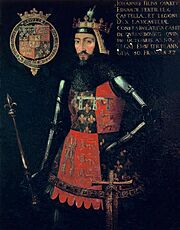
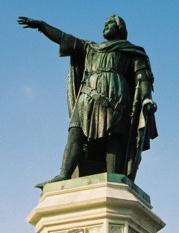
Many interesting people were born or lived in Ghent:
- Leo Baekeland (1863–1944), a chemist who invented Bakelite.
- Saint Bavo (589–654), the patron saint of Ghent.
- Charles V, Holy Roman Emperor (1500–1558), a very powerful emperor and king.
- Corneille Jean François Heymans (1892–1968), a physiologist who won the Nobel Prize in Physiology or Medicine.
- Victor Horta (1861–1947), a famous Art Nouveau architect.
- John of Gaunt (1340–1399), an English prince and military leader.
- Maurice Maeterlinck (1862–1949), a poet and playwright who won the Nobel Prize in Literature.
- Jacob van Artevelde (around 1290–1345), a statesman and political leader.
- Jan van Eyck (around 1385–1441), a famous painter.
- Kevin De Bruyne (born 1991), a professional football player for Manchester City.
- Jacques Rogge (1942–2021), who used to be the president of the IOC.
- Bradley Wiggins (born 1980), a famous British cyclist.
- Swen Vincke (born 1972), a video game director and head of Larian Studios.
Ghent's Sister Cities
Ghent has special connections with other cities around the world, called "twin towns" or "sister cities":
|
Images for kids
-
Cuberdon: A popular local delicacy
See also
 In Spanish: Gante para niños
In Spanish: Gante para niños



